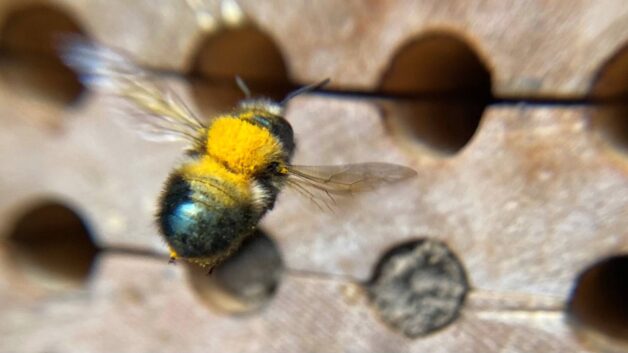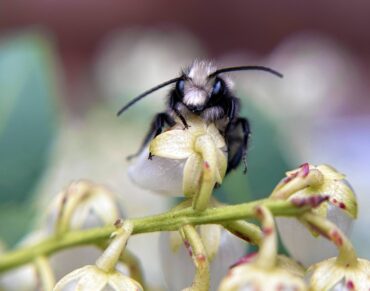 The Pacific Northwest is home to the native blue orchard mason bees. Often mistaken for houseflies due to their blue-green, iridescent bodies, these solitary bees are distinct from social bees because each female independently lays her own eggs, finds her own nest and gathers her own food. With 90% of bee species being solitary, these bees are crucial spring pollinators, effectively pollinating 95% of everything they land on. Lacking mandibles to chew wood, they rely on preexisting holes in their habitat for nesting.
The Pacific Northwest is home to the native blue orchard mason bees. Often mistaken for houseflies due to their blue-green, iridescent bodies, these solitary bees are distinct from social bees because each female independently lays her own eggs, finds her own nest and gathers her own food. With 90% of bee species being solitary, these bees are crucial spring pollinators, effectively pollinating 95% of everything they land on. Lacking mandibles to chew wood, they rely on preexisting holes in their habitat for nesting.
Every year, millions of bee hotels are purchased with the good intention of providing homes for mason bees. Unfortunately, many homeowners are unaware of the necessary maintenance, inadvertently putting mason bee populations at risk.
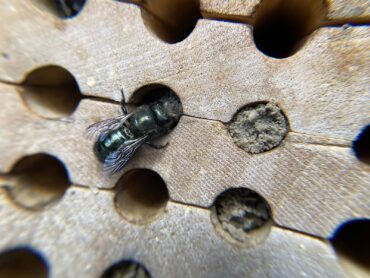 Just like honeybee hives, mason bee hotels require regular upkeep. In the wild, mason bees find natural holes that are camouflaged and difficult for predators to locate. However, when you set up a bee hotel, you’re providing easy access for predators.
Just like honeybee hives, mason bee hotels require regular upkeep. In the wild, mason bees find natural holes that are camouflaged and difficult for predators to locate. However, when you set up a bee hotel, you’re providing easy access for predators.
Researchers and industry experts have observed a rise in predators and parasites, significantly threatening these bees. If this issue is not addressed, bee hotels may become infested, further endangering mason bee populations.
Entomologist Abigail Lehner from the University of California, Davis Williams Bee Lab has observed an increase in invasive parasites through her studies. She notes, “Houdini flies and pollen mites are prevalent parasites we encounter in mason bee hotels. The only way to reduce the risk is to use proper nesting material and perform fall cleaning and sterilization of the cocoons and bee houses.”
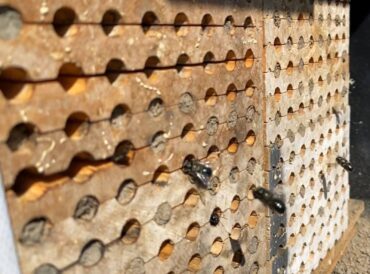 Four Steps for Year-Round Care
Four Steps for Year-Round Care
1. Use the correct nesting material. Avoid bamboo or logs with drilled holes, as they can become moldy and cannot be opened. Instead, use stacking trays or cardboard tubes.
2. Do not leave bee hotels out year-round. Mason bees live only six to eight weeks. At the end of spring, remove the nesting material from your yard and store it in a cool garage or shed to protect against summer predators like mono wasps and birds.
3. Harvest and clean cocoons in the fall. Fall maintenance is crucial. Remove all predators from the nesting material. Follow the steps outlined below.
4. Provide clean nesting material every spring. Set out new nesting material each spring. Old bee hotels may harbor predators that can harm emerging bees.
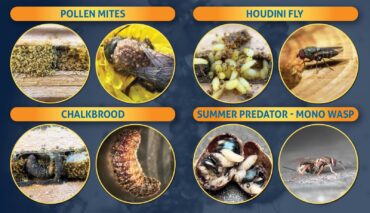 Mason Bee Predators
Mason Bee Predators
Protecting mason bees involves understanding the various predators that threaten them. By learning more, you can take effective steps to ensure the safety and health of your mason bees.
Houdini flies: Increasingly common in the Pacific Northwest, these kleptoparasites have red eyes and are the size of fruit flies. Houdini flies use mason bee nesting chambers to lay their eggs. They wait for the mason bee to leave her nest, then crawl inside and lay 10-15 eggs in the cell, which kills the mason bee larvae.
Pollen mites: These microscopic mites are collected on pollen and unknowingly carried back to the nesting chamber by mason bees. Inside the chamber, they multiply rapidly, consuming all the pollen and starving the mason bee larvae.
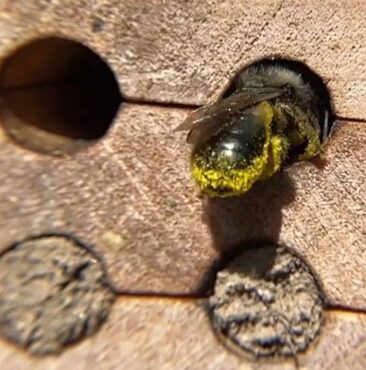 Chalkbrood: This fungal spore is found in pollen. When mason bee larvae ingest the spore, it dries them out and turns them black, killing the larvae. The spores then burst and spread inside the nesting material.
Chalkbrood: This fungal spore is found in pollen. When mason bee larvae ingest the spore, it dries them out and turns them black, killing the larvae. The spores then burst and spread inside the nesting material.
Mono wasps: This is a summer predator, which is why you want to remove nesting material at the end of spring. These wasps are the size of a fruit fly and are another type of kleptoparasite. They have what looks like a long stinger but it’s an ovipositor, which they use to poke into the cocoon and lay their eggs inside.
The Houdini fly larvae, pollen mites and chalkbrood will stay inside the nesting chamber all winter long and emerge with the mason bees the following spring. Over time, these predators can eliminate your entire mason bee population. Taking the proper steps to clean in the fall is critical in maintaining a healthy bee hotel.
Six Steps for Fall Maintenance
By fall, mason bees have created durable, waterproof silk cocoons and can safely be harvested. For detailed instructions, watch the step-by-step video “How to Harvest Mason Bee Cocoons.”
- Remove cocoons from nesting material. Gently remove all cocoons from the nesting material and prepare them for cleaning.
- Wash cocoons. Mason bee cocoons are waterproof and need to be washed in a mild bleach solution to remove pollen mites and chalkbrood.
- Dry cocoons. Allow the cocoons to dry overnight so they don’t mold during hibernation.
- Candle cocoons. Use a flashlight to identify and remove any nonviable cocoons that are amber or see-through.
- Sterilize nesting material. If you use stacking trays, use a flame to eliminate any remaining pollen mites or chalkbrood. Replace all cardboard tubes with new ones.
- Store in winter hibernation. Place the cleaned cocoons in a humidity-controlled container and store them in your refrigerator over the winter.
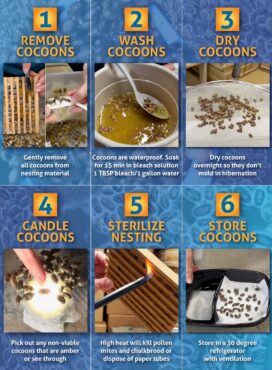 By taking care of your mason bees, you will help them emerge safely the following spring. Many homeowners love hosting mason bees due to their gentle behavior and efficient pollination skills, making them an increasingly popular choice for backyard pollinators.
By taking care of your mason bees, you will help them emerge safely the following spring. Many homeowners love hosting mason bees due to their gentle behavior and efficient pollination skills, making them an increasingly popular choice for backyard pollinators.
While some bee enthusiasts find fulfillment in the continuous care and cleaning of mason bees throughout the year, others may prefer a more hands-off approach. For those interested in supporting solitary bee populations and enhancing pollination in their yard without the responsibility of cleaning and storing mason bee cocoons during the winter, Rent Mason Bees offers a convenient program. This program provides everything you need to host mason bees, including the release of bees and the rental of nesting blocks, and handles all the cleaning and maintenance for you. To learn more, visit rentmasonbees.com.
Take action now to support mason bee populations by improving how you set up and care for their nesting sites. Together, we can preserve these essential pollinators — one bee hotel at a time.




